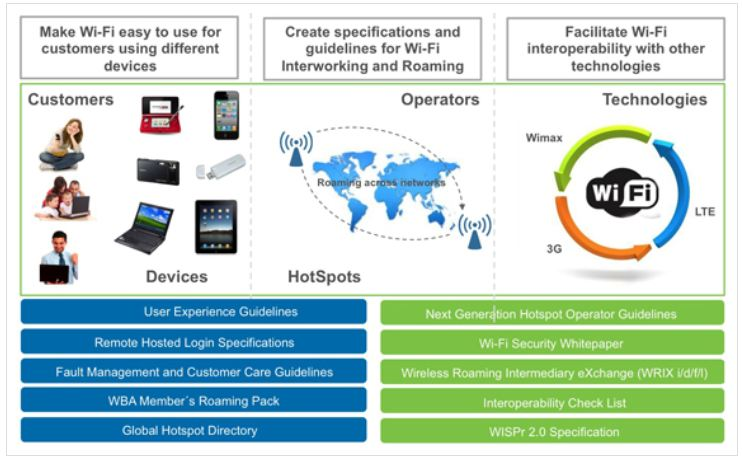We all love and at this point probably could not live without being always on/all ways connected, even if always and all ways remain a bit inspirational. It is one of the true joys of participating in live events, such as the ongoing Wireless Broadband Alliance (WBA) Wi-Fi Global Congress which I have been honored to moderate the past few days in San Francisco, that I have not only been able to hear about the latest developments in the progress and challenges facing the global broadband ecosystem as it moves to provide all of us with easy to us, secure and interoperable ubiquitous broadband access, but have been able to discuss them with the people making them happen.
I have already posted an item about the release of the WBA’s most recent study results on the path toward improved public Wi-Fi. I also had the privilege of being able to have a discussion with Shrikant Shenwai, CEO of the WBA, and his team to talk about the WBA and in particular how its spectacular growth in the past two years, and progress on its Next Generation Hotspot, is literally driving full steam ahead toward nothing short of a disruption/revolution of the way in which we can reach the fulfillment of being always on/always connected in a trusted manner.
As Shenwai noted, “This is an amazing time to be in the industry, attendance for the even reached a record level and the addition of 14 new members brings us up to 95 and we will soon pass 100. It is a reflection of the importance of public Wi-Fi to enabling all of us to have a great customer experience, and testimony to the criticality of making public Wi-Fi realize its full potential though the WBA initiatives like Next Generation Hotspot (NGH) and Wi-Fi roaming.”
Since a picture in many way is a better way to tell a story than too many words, under the WBA umbrella of making Wi-Fi seamless, secure and interoperable Shenwai and the team felt sharing the below was a great way to communicate to those unfamiliar with the WBA’s work a sense of what it is attempting to accomplish.

Source: Wireless Broadband Alliance
“But this is not just about Wi-Fi as a standalone capability,” Shenwani pointed out. “As can see from the diversity of our members and those participating in our event, including from the GSM Alliance and CableLabs, there is deep industry interest in the fact that WiFi is a complimentary technology to cellular. It can create new opportunities for the entire ecosystem from offload to being a platform for new revenue sources for everyone,” he added.
Shenwai zeroed in on HGN as the WBA’s top priority at the moment. As noted in my headline, this is good reason for this. The WBA is conducting NGH trials that will allow SIM and non-SIM based mobile devices, such as phones, notebooks and tablets, to simply roam on to Wi-Fi hotspots without the need for usernames and passwords. Many of the world’s largest operators and vendors have participated in these trials including AT&T, BT, Orange, NTT DOCOMO, China Mobile, Cisco, LG, Intel and Ericsson. And, many more are lining up to participate.
Putting aside industry jargon for a moment, the reason this is important is something we can all relate to because we have practical experience with it. The goal of NGH is to help end the sometime impossible task of finding a network and logging one when away from home. This is both non-trivial for us as users, but also is important to operators as they face a future where much of the explosive growth of broadband mobile data traffic is going to originate and terminate on Wi-Fi. Why? The easy answer from a user perspective is that it is free. From an operator perspective, in a spectrum scarce world and one where there is not enough capacity in the macro cellular world to accommodate that traffic at the edge of the network, along with small cell and LTE deployment Wi-Fi is the answer and making it easily accessible is fast becoming a priority. Indeed, Shenwai noted the study findings were, “Encouraging in terms of the projected rate of adoption of NGH. We are delighted to see that the community understands why this and WiFi roaming are so critical to everyone’s future.”
As the various common sessions, workshops, proof cases, business case preparation roundtables and panel discussions at the event have unfolded, Shenwai’s observation that, “We are delighted by the progress on NGH but there is a lot more work to be done,” have been more than substantiated. Just to name a few, and in no particular order, they include:
- Creating “Carrier Grade Wi-Fi”
- Making interoperability a reality not just between Wi-Fi implementations, but as seamlessly integrated with other radio network (RAN) elements and services
- Working out the business models and agreements for Wi-Fi to mirror what has been done in the cellular word and integrate with it
- Resolution of radio interference issues
- Hotspot citing in general
- Access to backhaul facilities and power
- Management and control not just of hotspots but of devices and identities
- Closer collaboration with device manufactures
That is the abridged list.
However, it is good to end where Shenwai started our discussion, it is a great time to be in the Wi-Fi business and what is most interesting is that for an industry that tends to move deliberately the future is heading at us incredibly fast and Wi-Fi is going to be both an enabler as well as a disrupter. That is why getting to know all about NGH is important, and why also staying on top of the work of organizations like the WBA and the GSMA commands ongoing attention.
Edited by
Brooke Neuman
 QUICK LINKS
QUICK LINKS